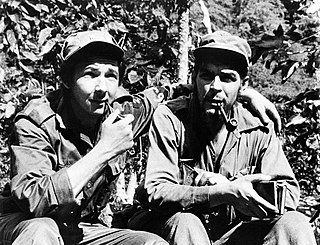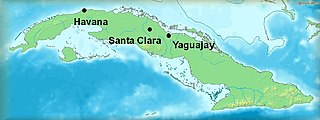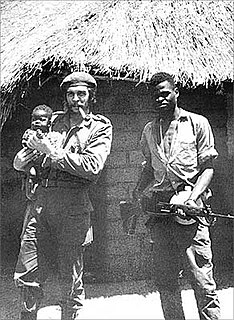 W
WThe Cuban Revolution was an armed revolt conducted by Fidel Castro's revolutionary 26th of July Movement and its allies against the military dictatorship of Cuban President Fulgencio Batista. The revolution began in July 1953, and continued sporadically until the rebels finally ousted Batista on 31 December 1958, replacing his government. 26 July 1953 is celebrated in Cuba as the Day of the Revolution . The 26th of July Movement later reformed along Marxist-Leninist lines, becoming the Communist Party in October 1965, and the government of Cuba later brought under its guise.
 W
WThe 26th of July Movement was a Cuban vanguard revolutionary organization and later a political party led by Fidel Castro. The movement's name commemorates its 26th July 1953 attack on the army barracks on Santiago de Cuba in an attempt to start the overthrowing of the dictator Fulgencio Batista.
 W
WBarbudos are bearded revolutionaries. The term was coined to describe the rebel forces of the Cuban Revolution. "Bearded men went in and out of Cienfuegos's office, rifles tossed backwards and forwards. Guevara in La Cabaña, a formidable presence, allowed Cienfuegos the headlines and maintained a discreet silence while ordering a prescription. Cienfuegos symbolized the rebel warrior who, Havana found to its surprise, behaved impeccably. The barbudos, as they became known, did not drink, did not loot, conducted themselves as if they were saints. No army had ever behaved like this in Havana."
 W
WThe Battle of La Plata (11-21 July 1958) was part of Operation Verano, the summer offensive of 1958 launched by the Batista government during the Cuban Revolution. The battle resulted from a complex plan created by Cuban General Cantillo to directly attack Castro's mountain base in the Sierra Maestra. The battle ended with the humiliating surrender of the assault battalion and the loss of some 500 Cuban army soldiers.
 W
WThe Battle of Las Mercedes was the last battle which occurred during the course of Operation Verano, the summer offensive of 1958 launched by the Batista Government during the Cuban Revolution.
 W
WThe Battle of Santa Clara was a series of events in late December 1958 that led to the capture of the Cuban city of Santa Clara by revolutionaries under the command of Che Guevara. The battle was a decisive victory for the rebels fighting against the regime of General Fulgencio Batista: within 12 hours of the city's capture, Batista fled Cuba and Fidel Castro's forces claimed overall victory. It features prominently on the back of the three convertible peso bill.
 W
WThe Battle of Yaguajay [(ɟ)ʝaɣwaˈxaj] was a decisive victory for the Cuban Revolutionaries over the soldiers of the Batista government near the city of Santa Clara in Cuba during the Cuban Revolution.
 W
WDirectorio Revolucionario Estudiantil (DRE) was a Cuban student group which in opposition to Cuban dictator Fulgencio Batista from 1954 to 1957 played a role in the Cuban Revolution, which came to power in 1959. In 1960, the Directorio was relaunched in opposition to Fidel Castro and moved its base to the United States, where it soon developed links with the Central Intelligence Agency. In August 1962 it carried out an attack on a beachfront Havana hotel. As of 1963 it was the largest anti-Castro student group in Miami; it also had a chapter in New Orleans, where it had contact with Lee Harvey Oswald in mid-1963. Immediately after the 22 November 1963 assassination of John F. Kennedy, it launched a campaign asserting that Lee Harvey Oswald had been acting on behalf of the Cuban government. The group lost its CIA support in December 1966.
 W
WThe foco theory of revolution by way of guerrilla warfare, also known as foquismo, was formulated by French intellectual and government official Régis Debray, whose main source of inspiration was Marxist revolutionary Che Guevara's experiences surrounding his rebel army's victory in the 1959 Cuban Revolution.
 W
WGranma is the yacht that was used to transport 82 fighters of the Cuban Revolution from Mexico to Cuba in November 1956 for the purpose of overthrowing the regime of Fulgencio Batista. The 60-foot diesel-powered cabin cruiser was built in 1943 by Wheeler Shipbuilding of Brooklyn NY as a light armored target practice boat, US Navy C-1994 and modified postwar to accommodate 12 people. "Granma", in English, is an affectionate term for a grandmother; the yacht is said to have been named for the previous owner's grandmother.
 W
WGuevarism is a theory of communist revolution and a military strategy of guerrilla warfare associated with communist revolutionary Ernesto "Che" Guevara, a leading figure of the Cuban Revolution who believed in the idea of Marxism–Leninism and embraced its principles.
 W
WEloy Gutiérrez Menoyo led the guerilla force Second National Front of the Escambray Mountains during the Cuban Revolution against Fulgencio Batista and later opposed the government of Fidel Castro over its pro-Soviet leanings. His brother Carlos Gutíerrez Menoyo died in the Presidential Palace Attack of March 13, 1957.
 W
WThe Moncada Barracks was a military barracks in Santiago de Cuba, named after the General Guillermón Moncada, a hero of the Cuban War of Independence. On 26 July 1953, the barracks was the site of an armed attack by a small group of revolutionaries led by Fidel Castro. The attack failed and the surviving revolutionaries were imprisoned. This armed attack is widely accepted as the beginning of the Cuban Revolution. The date on which the attack took place, 26 July, was adopted by Castro as the name for his revolutionary movement which eventually toppled the dictatorship of Fulgencio Batista on 12 January 1959.
 W
WThe Museum of the Revolution is located in the Old Havana section of Havana, Cuba. The museum is housed in what was the Presidential Palace of all Cuban presidents from Mario García Menocal to Fulgencio Batista. It became the Museum of the Revolution during the years following the Cuban Revolution. The palace building had been attacked by the Directorio Revolucionario Estudiantil in 1957.
 W
WThe attack on the presidential palace in Havana took place at around 3:30 PM on the March 13, 1957. The Directorio Revolucionario Estudiantil had the objective of killing Fulgencio Batista. The attack failed. According to one of the attackers, Faure Chomón of the Revolutionary Directorate, they were following the golpe arriba strategy and together with Menelao Mora Morales sought to overthrow the government by killing President Fulgencio Batista.
 W
WThe Cuban Revolution was not only fought by armed rebels on the battlefield but also through the propaganda campaigns designed and orchestrated by Fidel Castro and his rebel comrades. Propaganda in Cuba during revolution included Castro's use of personal interviews with journalists, radio broadcasts and publicity seeking operations that contributed significantly to the victory of the rebels over Fulgencio Batista's and provided insight into the successful propaganda campaign established by Castro after gaining power. The limited yet successful revolutionary propaganda apparatus transitioned into what Castro has called "one of the most potent weapons in his foreign policy arsenal." Today the Cuban government maintains an intricate propaganda machine that includes a global news agency, magazines, newspapers, broadcasting facilities, publishing houses, front groups, and other miscellaneous organizations that all stem from the modest beginnings of Castro's revolutionary propaganda machine.
 W
WSecond National Front of Escambray was an independent guerilla group led by Eloy Gutiérrez Menoyo and Dr. Armando Fleites and included Roger Redondo, Ramiro Lorenzo, Jorge Castellón, Jesús Carreras Saya, Lázaro Artola, Genaro Arroyo, and others in the Cuban central Escambray Mountains. William Alexander Morgan was also a part of the Escambray group. While initially the group supported Fidel Castro in his efforts to overthrow Cuban dictator Fulgencio Batista, after Castro took power some of its members joined former Batista soldiers and local farmers in the Escambray Rebellion (1959-1965) opposing Castro.
 W
WThe Tren Blindado is a national monument, memorial park, and museum of the Cuban Revolution, located in the city of Santa Clara, Cuba. It was created in memory of the events of 29 December 1958, during the Battle of Santa Clara, by the Cuban sculptor José Delarra.